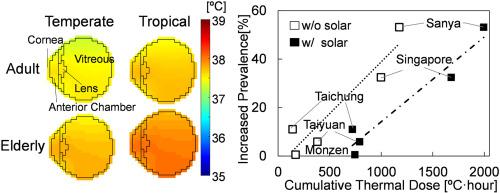Computers in Biology and Medicine ( IF 7.0 ) Pub Date : 2020-09-19 , DOI: 10.1016/j.compbiomed.2020.104009 Sachiko Kodera 1 , Akimasa Hirata 2 , Fumiaki Miura 1 , Essam A Rashed 3 , Natsuko Hatsusaka 4 , Naoki Yamamoto 4 , Eri Kubo 4 , Hiroshi Sasaki 4

|
Recent epidemiological studies have hypothesized that the prevalence of cortical cataracts is closely related to ultraviolet radiation. However, the prevalence of nuclear cataracts is higher in elderly people in tropical areas than in temperate areas. The dominant factors inducing nuclear cataracts have been widely debated. In this study, the temperature increase in the lens due to exposure to ambient conditions was computationally quantified in subjects of 50–60 years of age in tropical and temperate areas, accounting for differences in thermoregulation. A thermoregulatory response model was extended to consider elderly people in tropical areas. The time course of lens temperature for different weather conditions in five cities in Asia was computed. The temperature was higher around the mid and posterior part of the lens, which coincides with the position of the nuclear cataract. The duration of higher temperatures in the lens varied, although the daily maximum temperatures were comparable. A strong correlation (adjusted R2 > 0.85) was observed between the prevalence of nuclear cataract and the computed cumulative thermal dose in the lens. We propose the use of a cumulative thermal dose to assess the prevalence of nuclear cataracts. Cumulative wet-bulb globe temperature, a new metric computed from weather data, would be useful for practical assessment in different cities.
中文翻译:

基于模型的老年人核性白内障患病率分析方法
最近的流行病学研究假设,皮质性白内障的患病率与紫外线辐射密切相关。然而,热带地区老年人的核白内障患病率高于温带地区。引起核性白内障的主要因素已被广泛讨论。在这项研究中,在热带和温带地区,年龄在50至60岁之间的受试者中,由于暴露于周围环境而导致的晶状体温度升高在计算上得到了量化,这说明了温度调节的差异。扩展了温度调节反应模型,以考虑热带地区的老年人。计算了亚洲五个城市不同天气条件下的镜头温度的时程。晶状体中部和后部附近的温度较高,这与核性白内障的位置重合。尽管每天的最高温度是可比的,但镜片中较高温度的持续时间却有所不同。较强的相关性(调整后的R2 > 0.85)在核性白内障患病率与晶状体中计算出的累积热剂量之间观察到。我们建议使用累积热剂量来评估核性白内障的患病率。根据天气数据计算得出的一种新的度量标准,即湿球地球仪的累积温度,将有助于不同城市的实际评估。











































 京公网安备 11010802027423号
京公网安备 11010802027423号